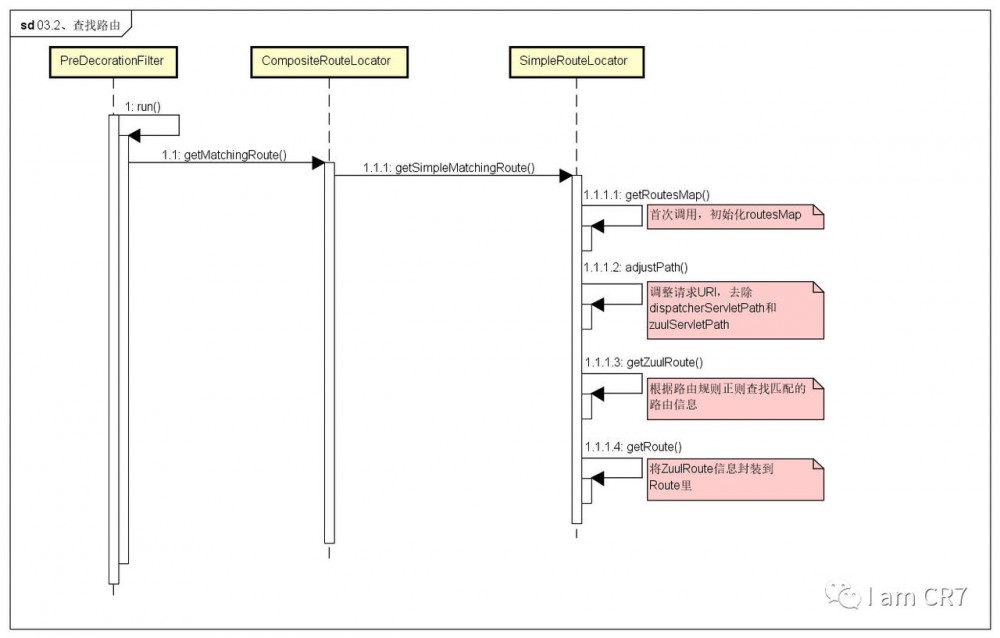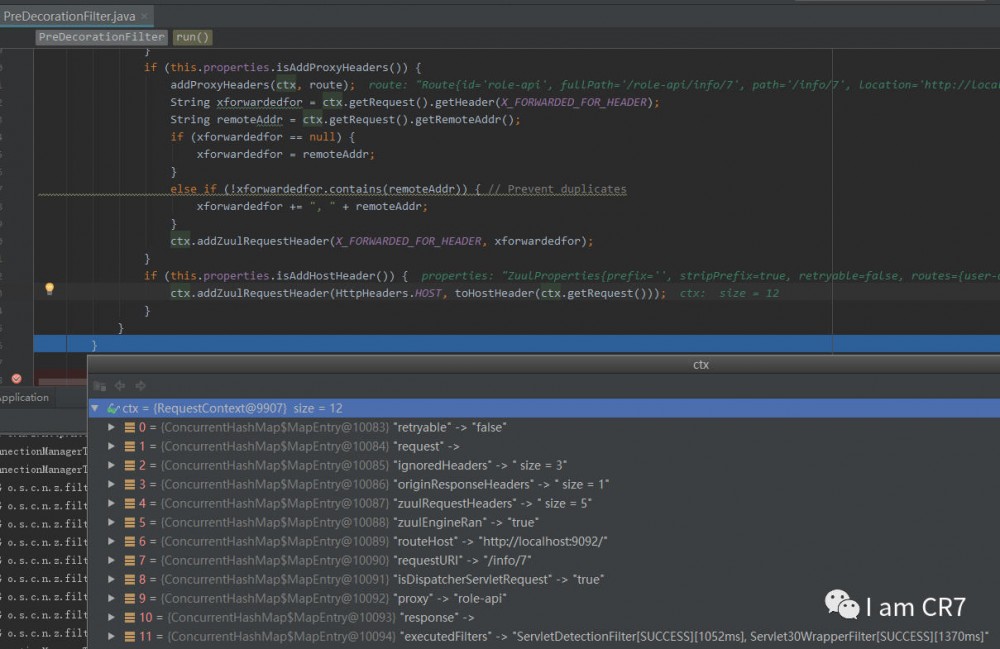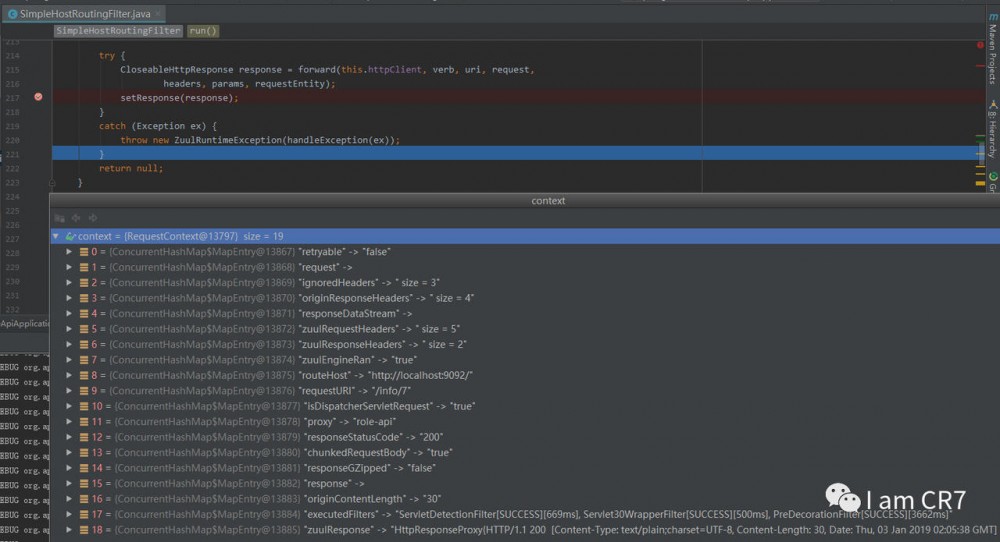Spring Cloud Netflix Zuul源码分析之请求处理篇-下
微信公众号:如有问题或建议,请在下方留言;
最近更新:2019-01-03
前言
因篇幅原因,上一部分内容请看: Spring Cloud Netflix Zuul源码分析之请求处理篇-上
PreDecorationFilter
该类的作用就是查找对应的路由信息,获取后端微服务的地址,保存到请求上下文,提供给路由过滤器使用。
简化版run方法
1@Override
2public Object run() {
3 RequestContext ctx = RequestContext.getCurrentContext();
4 final String requestURI = this.urlPathHelper.getPathWithinApplication(ctx.getRequest());
5 // 根据URI从路由规则里获取对应的路由
6 Route route = this.routeLocator.getMatchingRoute(requestURI);
7 if (route != null) {
8 // 将获取到路由信息放入请求上下文
9 } else{
10 // 找不到路由,则fallback到DispatcherServlet
11 }
12}
复制代码
查找路由
时序图

源码
这里特地列出简单URL是如何查找路由的源码,请看:
1// SimpleRouteLocator
2protected ZuulRoute getZuulRoute(String adjustedPath) {
3 if (!matchesIgnoredPatterns(adjustedPath)) {
4 for (Entry<String, ZuulRoute> entry : getRoutesMap().entrySet()) {
5 String pattern = entry.getKey();
6 log.debug("Matching pattern:" + pattern);
7 // 利用正则表达式进行path匹配,找到对应的路由
8 if (this.pathMatcher.match(pattern, adjustedPath)) {
9 return entry.getValue();
10 }
11 }
12 }
13 return null;
14}
复制代码
断点图
经过该过滤器执行后,请求上下文RequestContext内容为:

SimpleHostRoutingFilter
该过滤器的作用是调用原生httpClient发送请求到后端微服务,解析响应结果,写入请求上下文,提供给后置过滤器使用。
执行
1@Override
2public Object run() {
3 RequestContext context = RequestContext.getCurrentContext();
4 HttpServletRequest request = context.getRequest();
5 // 根据请求构建Zuul请求的Headers
6 MultiValueMap<String, String> headers = this.helper
7 .buildZuulRequestHeaders(request);
8 // 根据请求构建Zuul请求的queryParams
9 MultiValueMap<String, String> params = this.helper
10 .buildZuulRequestQueryParams(request);
11 String verb = getVerb(request);
12 InputStream requestEntity = getRequestBody(request);
13 if (getContentLength(request) < 0) {
14 context.setChunkedRequestBody();
15 }
16 // 根据请求构建Zuul请求的URI
17 String uri = this.helper.buildZuulRequestURI(request);
18 this.helper.addIgnoredHeaders();
19
20 try {
21 // 调用原生httpClient转发请求
22 CloseableHttpResponse response = forward(this.httpClient, verb, uri, request,
23 headers, params, requestEntity);
24 // 保存响应结果
25 setResponse(response);
26 }
27 catch (Exception ex) {
28 throw new ZuulRuntimeException(handleException(ex));
29 }
30 return null;
31}
复制代码
转发请求
1private CloseableHttpResponse forward(CloseableHttpClient httpclient, String verb,
2 String uri, HttpServletRequest request, MultiValueMap<String, String> headers,
3 MultiValueMap<String, String> params, InputStream requestEntity)
4 throws Exception {
5 Map<String, Object> info = this.helper.debug(verb, uri, headers, params,
6 requestEntity);
7 // routeHost就是在前置过滤器PreDecorationFilter中添加的
8 URL host = RequestContext.getCurrentContext().getRouteHost();
9 // 创建HttpHost,指定请求目标地址
10 HttpHost httpHost = getHttpHost(host);
11 uri = StringUtils.cleanPath(MULTIPLE_SLASH_PATTERN.matcher(host.getPath() + uri).replaceAll("/"));
12 long contentLength = getContentLength(request);
13
14 ContentType contentType = null;
15
16 if (request.getContentType() != null) {
17 contentType = ContentType.parse(request.getContentType());
18 }
19
20 InputStreamEntity entity = new InputStreamEntity(requestEntity, contentLength,
21 contentType);
22
23 // 创建HttpRequest
24 HttpRequest httpRequest = buildHttpRequest(verb, uri, entity, headers, params,
25 request);
26 try {
27 log.debug(httpHost.getHostName() + " " + httpHost.getPort() + " "
28 + httpHost.getSchemeName());
29 // 调用原生httpClient发送请求
30 CloseableHttpResponse zuulResponse = forwardRequest(httpclient, httpHost,
31 httpRequest);
32 this.helper.appendDebug(info, zuulResponse.getStatusLine().getStatusCode(),
33 revertHeaders(zuulResponse.getAllHeaders()));
34 return zuulResponse;
35 }
36 finally {
37 // When HttpClient instance is no longer needed,
38 // shut down the connection manager to ensure
39 // immediate deallocation of all system resources
40 // httpclient.getConnectionManager().shutdown();
41 }
42}
43
44private CloseableHttpResponse forwardRequest(CloseableHttpClient httpclient,
45 HttpHost httpHost, HttpRequest httpRequest) throws IOException {
46 return httpclient.execute(httpHost, httpRequest);
47}
复制代码
保存响应
1private void setResponse(HttpResponse response) throws IOException {
2 RequestContext.getCurrentContext().set("zuulResponse", response);
3 this.helper.setResponse(response.getStatusLine().getStatusCode(),
4 response.getEntity() == null ? null : response.getEntity().getContent(),
5 revertHeaders(response.getAllHeaders()));
6}
7// ProxyRequestHelper
8public void setResponse(int status, InputStream entity,
9 MultiValueMap<String, String> headers) throws IOException {
10 RequestContext context = RequestContext.getCurrentContext();
11 context.setResponseStatusCode(status);
12 if (entity != null) {
13 context.setResponseDataStream(entity);
14 }
15
16 boolean isOriginResponseGzipped = false;
17 for (Entry<String, List<String>> header : headers.entrySet()) {
18 String name = header.getKey();
19 for (String value : header.getValue()) {
20 context.addOriginResponseHeader(name, value);
21
22 if (name.equalsIgnoreCase(HttpHeaders.CONTENT_ENCODING)
23 && HTTPRequestUtils.getInstance().isGzipped(value)) {
24 isOriginResponseGzipped = true;
25 }
26 if (name.equalsIgnoreCase(HttpHeaders.CONTENT_LENGTH)) {
27 context.setOriginContentLength(value);
28 }
29 if (isIncludedHeader(name)) {
30 context.addZuulResponseHeader(name, value);
31 }
32 }
33 }
34 context.setResponseGZipped(isOriginResponseGzipped);
35}
复制代码
断点图

SendResponseFilter
该过滤器的作用是将请求上下文里的响应信息写入到响应内容,返回给请求客户端。
执行
1@Override
2public Object run() {
3 try {
4 addResponseHeaders();
5 writeResponse();
6 }
7 catch (Exception ex) {
8 ReflectionUtils.rethrowRuntimeException(ex);
9 }
10 return null;
11}
复制代码
添加响应Header
1private void addResponseHeaders() {
2 RequestContext context = RequestContext.getCurrentContext();
3 HttpServletResponse servletResponse = context.getResponse();
4 if (this.zuulProperties.isIncludeDebugHeader()) {
5 @SuppressWarnings("unchecked")
6 List<String> rd = (List<String>) context.get(ROUTING_DEBUG_KEY);
7 if (rd != null) {
8 StringBuilder debugHeader = new StringBuilder();
9 for (String it : rd) {
10 debugHeader.append("[[[" + it + "]]]");
11 }
12 servletResponse.addHeader(X_ZUUL_DEBUG_HEADER, debugHeader.toString());
13 }
14 }
15 List<Pair<String, String>> zuulResponseHeaders = context.getZuulResponseHeaders();
16 if (zuulResponseHeaders != null) {
17 for (Pair<String, String> it : zuulResponseHeaders) {
18 servletResponse.addHeader(it.first(), it.second());
19 }
20 }
21 if (includeContentLengthHeader(context)) {
22 Long contentLength = context.getOriginContentLength();
23 if(useServlet31) {
24 servletResponse.setContentLengthLong(contentLength);
25 } else {
26 //Try and set some kind of content length if we can safely convert the Long to an int
27 if (isLongSafe(contentLength)) {
28 servletResponse.setContentLength(contentLength.intValue());
29 }
30 }
31 }
32}
复制代码
写出响应
1private void writeResponse() throws Exception {
2 RequestContext context = RequestContext.getCurrentContext();
3 // there is no body to send
4 if (context.getResponseBody() == null
5 && context.getResponseDataStream() == null) {
6 return;
7 }
8 HttpServletResponse servletResponse = context.getResponse();
9 if (servletResponse.getCharacterEncoding() == null) { // only set if not set
10 servletResponse.setCharacterEncoding("UTF-8");
11 }
12
13 OutputStream outStream = servletResponse.getOutputStream();
14 InputStream is = null;
15 try {
16 if (context.getResponseBody() != null) {
17 String body = context.getResponseBody();
18 is = new ByteArrayInputStream(
19 body.getBytes(servletResponse.getCharacterEncoding()));
20 }
21 else {
22 is = context.getResponseDataStream();
23 if (is!=null && context.getResponseGZipped()) {
24 // if origin response is gzipped, and client has not requested gzip,
25 // decompress stream before sending to client
26 // else, stream gzip directly to client
27 if (isGzipRequested(context)) {
28 servletResponse.setHeader(ZuulHeaders.CONTENT_ENCODING, "gzip");
29 }
30 else {
31 is = handleGzipStream(is);
32 }
33 }
34 }
35
36 if (is!=null) {
37 writeResponse(is, outStream);
38 }
39 }
40 finally {
41 if (is != null) {
42 try {
43 is.close();
44 }
45 catch (Exception ex) {
46 log.warn("Error while closing upstream input stream", ex);
47 }
48 }
49
50 try {
51 Object zuulResponse = context.get("zuulResponse");
52 if (zuulResponse instanceof Closeable) {
53 ((Closeable) zuulResponse).close();
54 }
55 outStream.flush();
56 // The container will close the stream for us
57 }
58 catch (IOException ex) {
59 log.warn("Error while sending response to client: " + ex.getMessage());
60 }
61 }
62}
63
64private void writeResponse(InputStream zin, OutputStream out) throws Exception {
65 byte[] bytes = buffers.get();
66 int bytesRead = -1;
67 while ((bytesRead = zin.read(bytes)) != -1) {
68 out.write(bytes, 0, bytesRead);
69 }
70}
复制代码
小结
通过上述分析,简单URL请求,Zuul做的哪些事情,就一目了然了:
- 根据请求URI正则匹配路由配置规则,找到后端微服务的具体地址
- 调用原生httpClient发送请求到后端微服务
- 解析后端微服务的响应结果,返回给请求方
不知道大家有没有注意到,从始至终有一个类一直贯穿整个处理的过程。谁?Filter?不,是RequestContext。ZuulServlet处理过程就是靠它在前置、路由、后置各过滤器间实现信息传递,由此可见它的重要性。接下来,我们就走进RequestContext,揭开这位“信使”的神秘“面纱”。
RequestContext
既然RequestContext用来传递信息,那么它的正确性就必须得保证。在多线程情况下,如何做到这一点呢?请往下看:
1public class RequestContext extends ConcurrentHashMap<String, Object> {
2
3 private static final Logger LOG = LoggerFactory.getLogger(RequestContext.class);
4
5 protected static Class<? extends RequestContext> contextClass = RequestContext.class;
6
7 private static RequestContext testContext = null;
8
9 protected static final ThreadLocal<? extends RequestContext> threadLocal = new ThreadLocal<RequestContext>() {
10 // 覆盖ThreadLocal里initialValue方法,设置ThreadLocal的值
11 @Override
12 protected RequestContext initialValue() {
13 try {
14 return contextClass.newInstance();
15 } catch (Throwable e) {
16 throw new RuntimeException(e);
17 }
18 }
19 };
20}
复制代码
是不是明白了一些,对,就是这两大并发神器:ConcurrentHashMap和ThreadLocal。前面提到的几个过滤器里,使用RequestContext时,都是如下写法:
1RequestContext context = RequestContext.getCurrentContext(); 2context.set***(); 3context.get***(); 复制代码
getCurrentContext()就是入口:
1public static RequestContext getCurrentContext() {
2 if (testContext != null) return testContext;
3
4 RequestContext context = threadLocal.get();
5 return context;
6}
复制代码
从ThreadLocal里获取RequestContext:
1public T get() {
2 Thread t = Thread.currentThread();
3 ThreadLocalMap map = getMap(t);
4 if (map != null) {
5 ThreadLocalMap.Entry e = map.getEntry(this);
6 if (e != null) {
7 @SuppressWarnings("unchecked")
8 T result = (T)e.value;
9 return result;
10 }
11 }
12 return setInitialValue();
13}
14
15private T setInitialValue() {
16 // 覆盖该方法,设置ThreadLocal的值
17 T value = initialValue();
18 Thread t = Thread.currentThread();
19 ThreadLocalMap map = getMap(t);
20 if (map != null)
21 map.set(this, value);
22 else
23 createMap(t, value);
24 return value;
25}
复制代码
通过覆盖ThreadLocal的initialValue方法,首次调用时设置值,后续调用判断当前线程已经绑定了值,则直接返回。这样就保证了不同的请求都有自己的RequestContext。因为RequestContext继承自ConcurrentHashMap,是一个线程安全的map,从而保证了并发下的正确性。
补充:这里只是简单讲解了ThreadLocal和ConcurrentHashMap,不在本文中详细展开,后续会写文章去做深入分析。
总结
到这里,我们就讲完了一个简单URL请求在Zuul中整个处理过程。写作过程中,笔者一直在思考,如何行文能让大家更好的理解。虽然修改了很多次,但是还是觉得不够完美,只能一边写一边总结一边改进。希望大家多多留言,给出意见和建议,那笔者真是感激不尽!!!最后,感谢大家的支持,祝新年快乐,祁琛,2019年1月3日。
- 本文标签: 源码 文章 Netflix map tk 解析 client IO https equals 多线程 list zip ACE Spring cloud 安全 并发 App build message ip ConcurrentHashMap IDE value spring http bug cat stream CTO Connection servlet 微信公众号 HashMap UI key 正则表达式 entity id 线程 微服务 CEO 总结 db 神器 zuul 配置 parse src 希望 Proxy 代码 final
- 版权声明: 本文为互联网转载文章,出处已在文章中说明(部分除外)。如果侵权,请联系本站长删除,谢谢。
- 本文海报: 生成海报一 生成海报二











![[HBLOG]公众号](https://www.liuhaihua.cn/img/qrcode_gzh.jpg)

